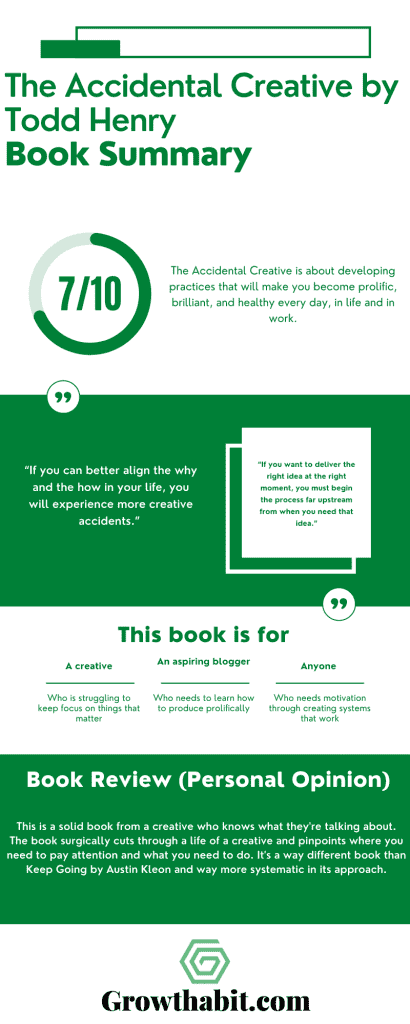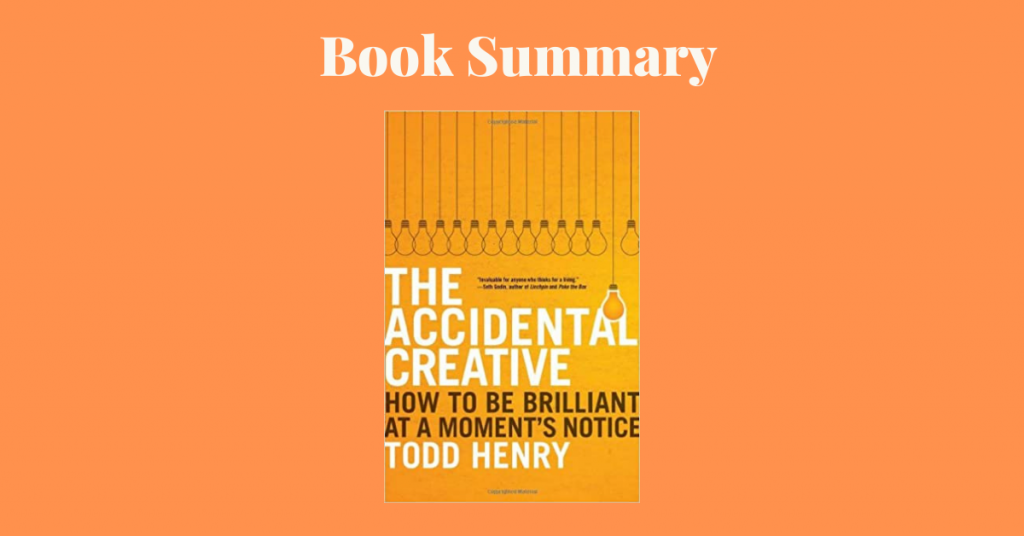The Accidental Creative is about developing practices that will make you become prolific, brilliant, and healthy every day, in life and in work.
Book Title: The Accidental Creative: How to Be Brilliant at a Moment’s Notice Paperback
Author: Todd Henry
Date of Reading: February 2018
Rating: 7/10
What Is Being Said In Detail:
The Accidental Creative by Todd Henry is a book that answers three questions. How to come at work and:
- Invent brilliant solutions
- Meet specific objectives
- Under predefined deadlines
The entire book is based on answering these three questions and making creatives prolific, brilliant, and healthy. To do that, Henry leads us through ten chapters divided into two sections: The Dynamics and Creative Rythm.
The Dynamics
The Dynamics has three chapters:
- Chapter 1. – THE DYNAMICS OF CREATIVE WORK talks about why you need to be prolific, brilliant, and healthy. If you have two, but lack the third one, you’re in some serious problems. If you lack health, you will become burnout. If you lack brilliance, you will get fired. And if you’re not prolific, you won’t be reliable.
- Chapter 2. – THE DYNAMICS OF TEAM WORK talks about how the creative should work in organizations. Creative breakthroughs rarely happen in isolation— they’re a result of a team of people stumbling on a solution.
- Chapter 3. – THE SIDE EFFECTS: DEALING WITH THE ASSASSINS OF CREATIVITY talks about making things as simple as possible so they don’t interfere with the creative process. The chapter also mentions breaking off from your mentors so you don’t stifle your creative freedom (when you’re ready).
The Creative Rhythm
The second part of the book, Creative Rhythm, has seven chapters:
- Chapter 4. – FOCUS: ZEROING IN ON WHAT’S CRITICAL talks about separating your concrete (doing) time with your conceptual (thinking/planning) time so you don’t waste time switching between tasks.
- Chapter 5. – RELATIONSHIPS: BEING BRILLIANT TOGETHER talks about how you need to have three types of relationships: ones where you feel safe, ones where you can take risks, and one where you can listen to the wisdom of others.
- Chapter 6. – ENERGY: YOUR INVISIBLE ALLY talks about energy management and how you need to pay attention only on things that matter.
- Chapter 7. – STIMULI: WHAT GOES IN MUST COME OUT talks about the old principle of “garbage in, garbage out.” The chapter explains the importance of having two kinds of stimuli: one for personal growth and the other for professional growth.
- Chapter 8. – HOURS: THEY’RE THE CURRENCY OF PRODUCTIVITY talks about the importance of saying no to things that aren’t a priority, putting tasks on the calendar, and being “inflexibly flexible” with your time.
- Chapter 9 – PUTTING IT ALL TOGETHER: THE CHECKPOINTS talks about you not being a slave to your processes. They are there to serve you, not the other way around. Keep it simple.
- Chapter 10. – COVER BANDS DON’T CHANGE THE WORLD talks about making commitments to yourself and to others. It’s about putting it all out there and having no regrets about the things you wanted to do.
Most Important Keywords, Sentences, Quotes:
INTRODUCTION THE ACCIDENTAL CREATIVE
“On our best days it seems almost unfair that we get paid to do what we do, but on our worst days our jobs feel pretty much like any other”
“For the traditional creatives, such as designers, writers, visual artists, musicians, and performers, this book will help you establish enough structure in your life to get the most out of your creative process. It will also teach you how to stay engaged and prolific over the long term, which is often a problem for artists who must produce continually on demand.”
“If you want to deliver the right idea at the right moment, you must begin the process far upstream from when you need that idea.”
“It’s not what you know that matters, it’s what you do. Regardless of what others may promise, there are no quick fixes or easy steps to supercharge your creativity. You will unleash your latent creative ability through regular, purposeful practice of the principles in this book. There are most certainly insights and “aha!” moments to be found in these pages, but knowledge alone won’t do the job any more than knowing the fundamentals of how to exercise will keep you physically healthy. You must be purposeful and intentional. The results are worth it.”
PART 1 – THE DYNAMICS
Chapter 1. – THE DYNAMICS OF CREATIVE WORK
“Prolific + Brilliant + Healthy = producing great work consistently and in a sustainable way”
“This is the most effective way to live and work. It means producing a large volume of high-quality work over long periods of time. In my experience, most creatives consistently perform very well in two of these areas, but are lacking at least one of them. For instance, Prolific + Brilliant – Healthy = Burnout”
“Hard work is an absolute necessity if you want to do anything worthwhile. In fact, if you apply the principles in this book, you will probably end up working harder than you ever have in your entire career. But what you must avoid is the kind of frenetic activity that seems like productivity but is really more about the appearance of being busy than the actual accomplishment of effective work.”
“Healthy + Prolific – Brilliant = Fired”
”The enemy of art is the absence of limitations.” —Orson Welles”
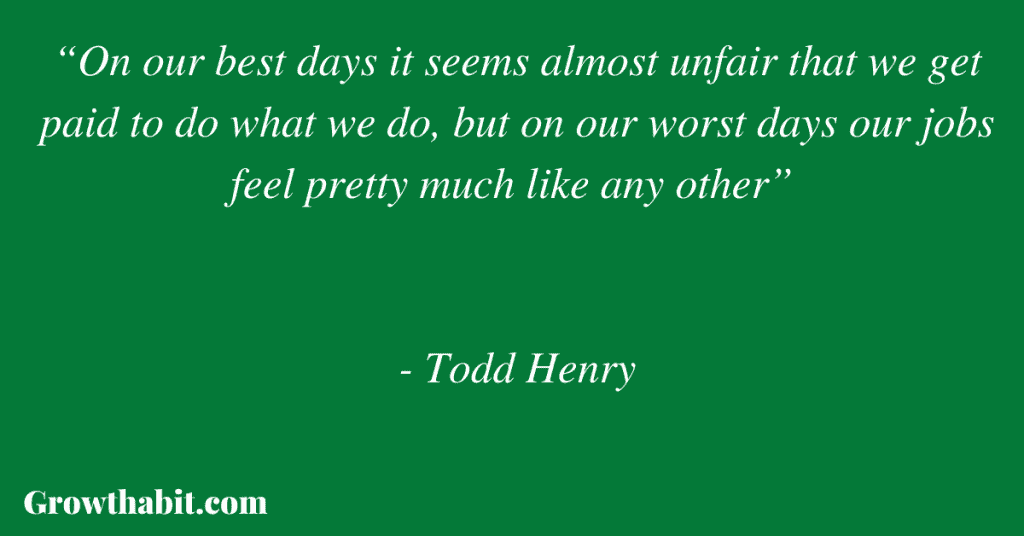
“The reality is that we are not capable of operating without boundaries. We need them in order to focus our creative energy into the right channels. Total freedom is false freedom. True freedom has healthy boundaries.”
“If we could harness the sum total of wasted energy each day in the workplace, we could probably power the earth for a year. There is so much ineffective work because there is often a lack of clarity around what we’re really trying to do.”
Chapter 2. – THE DYNAMICS OF TEAM WORK
“Organizations organize. It’s their reason for being. And organization is good, because it allows groups of people to leverage assets more efficiently and scale in ways that aren’t possible for individuals.”
“the ideal of the lone innovator, slaving away in the garage or studio to bring a vision to life, the reality is that most of the time brilliant creations are the result of teams of people stumbling awkwardly into the unknown.”
“A worker exchanges a certain number of hours per week for a fair wage. If you are a good worker, you work hard all day long for your paycheck, and then at quitting time you go home and forget about your job for the evening.”
“As a creative worker, you’re not really paid for your time, you’re paid for the value you create.”
“completion anxiety. Because we’re capable of working at all times—our mind goes with us everywhere, after all—we continue working on our projects for as long as we possibly can. We’re never really certain when we’ve done enough.”
“In spite of the increasing flexibility that many workplaces are introducing and the growing number of freelancers, many of us are actually working more hours than ever because it’s so difficult to draw the line between work time and nonwork time.”
”Few things in life are less efficient than a group of people trying to write a sentence. The advantage of this method is that you end up with something for which you will not be personally blamed.”
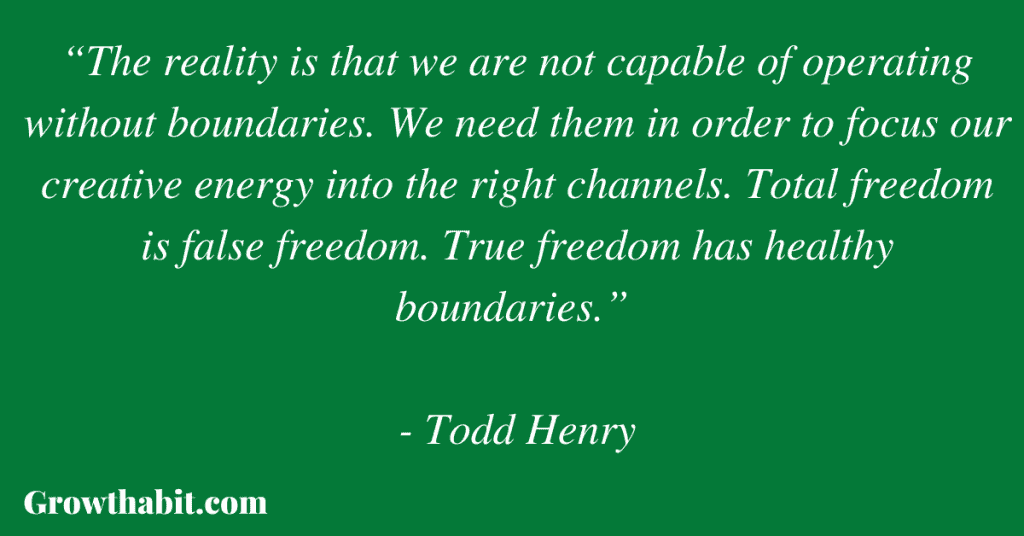
“It takes an incredible amount of willpower not to work when we are technically off the clock. Additionally, many of us love the work we do and would probably rather be working than doing any of the many other things we could be doing. We’re actually choosing to work perpetually! We’ve adopted a working lifestyle. It’s as natural to us as blinking and breathing.”
“The organization is primarily concerned with the finished product, but 99 percent of what we do as creatives is process.”
Chapter 3. – THE SIDE EFFECTS: DEALING WITH THE ASSASSINS OF CREATIVITY
“Working in the create-on-demand world, expected to be constantly on, you probably experience each of these side effects on a regular basis. Just like your car may continue to run for a while in disrepair, you can be very effective in short bursts, even violating your natural rhythms for a time, but eventually the negative side effects will catch up to you in the form of these symptoms.”
”We deliver innovative solutions to clients!” (But just give the clients whatever they ask for.) “We value team and collaboration!” (But really, just do what we tell you and don’t ask questions.) “We value our people!” (But we’re going to have to ask you to work again this weekend.)”
”Making the simple complicated is commonplace; making the complicated simple, awesomely simple, that’s creativity.” —Charles Mingus”
“We make things very complex in order to mask the reality that, deep down, we’re confused about our true objectives. Some of us (myself included) use unnecessary complexity as a mask for insecurity. (If we aren’t certain we can nail the project, we’ll at least confuse the heck out of them and show them how smart we are.) This is a waste of creative brainpower and does nothing to get us closer to our objectives.”
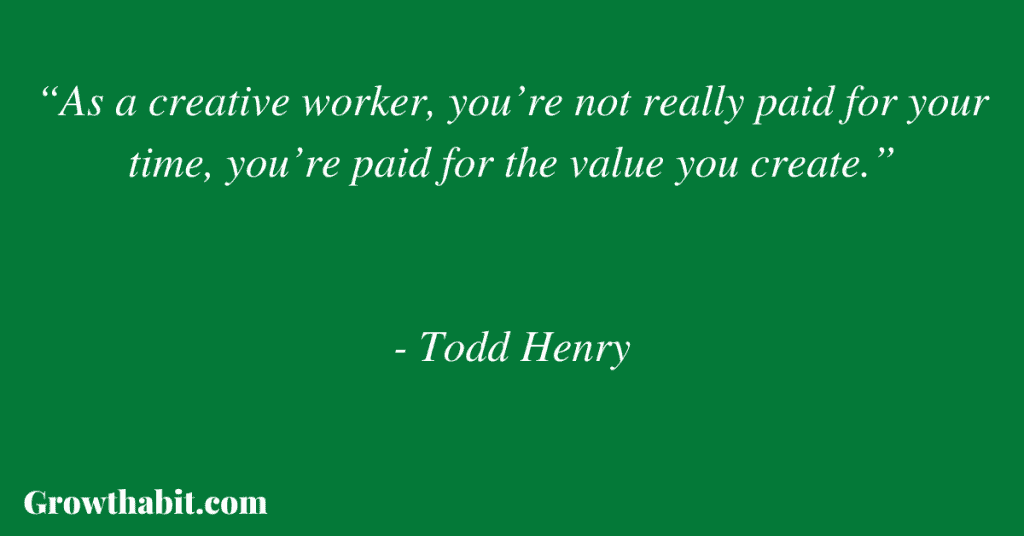
“Because so many teams begin with execution (creative strategy) and skip over the objectives (project strategy), dissonance creeps into the work. We must make certain that the why (project strategy) and the how (creative strategy) line up.”
“If you can better align the why and the how in your life, you will experience more creative accidents.”
“improvisational violinist Stephen Nachmanovitch writes, “It’s great to sit on the shoulders of giants, but don’t let the giants sit on your shoulders. There’s no room for their legs to dangle!” In other words, there is a form of oppression that emerges when we allow the work of our influences or competitors to drive our creating in an unhealthy way.”
“We often reject ideas that seem too simple or too obvious out of hand. If something is simple, the thinking goes, it must be ineffective. But the greatest performers across a wide spectrum of fields understand that the most basic and fundamental practices ultimately lay the foundation for brilliant results.”
“Remember that common sense is not common practice, and that people who succeed are often those who do the little, everyday things that others won’t.”
PART 2 – CREATIVE RHYTHM
Chapter 4. – FOCUS: ZEROING IN ON WHAT’S CRITICAL
“lock in on the heart of the problem quickly (define), establish your game plan to center your activities around the most crucial priorities (refine), and organize your work so that you’re minimizing distractions and staying on course (cluster).”
“Inventor Charles F. Kettering famously said that “a problem well-stated is a problem half-solved.”
“• Separate your conceptual/creative time from your concrete /task time. When you fragment your day with fifteen minutes of design or writing, ten minutes of invoicing and time tracking, five minutes of e-mail, et cetera, you are paying a significant task-switching penalty. Try to give yourself—as much as you are able—no less than a half hour of uninterrupted time whenever you are doing design, writing, or other largely conceptual work, and an hour is preferable. If the projects don’t require that much time, try to cluster a few together. Not only will this help you stay focused longer, you will also regain a significant amount of time wasted by switching programs, moving windows around on your screen, and quickly checking that funny little headline that caught your eye.”
Chapter 5. – RELATIONSHIPS: BEING BRILLIANT TOGETHER
“The key to cultivating creatively stimulating relationship is threefold: you need relationships in your life in which you can be real, you need relationships in your life in which you can learn to risk, and you need relationships in your life in which you can learn to submit to the wisdom of others.”
“two critical elements of any successful relationship: intimacy and generosity.”
”Anyone can sympathize with the sufferings of a friend, but it requires a very fine nature to sympathize with a friend’s success.” —Oscar Wilde”
“The other crucial element of successful relationships is generosity. The creative process is an inherently generous act. Whether we are developing a strategy or crafting a piece of art, creating is primarily about sharing our insights and perspectives with others.”
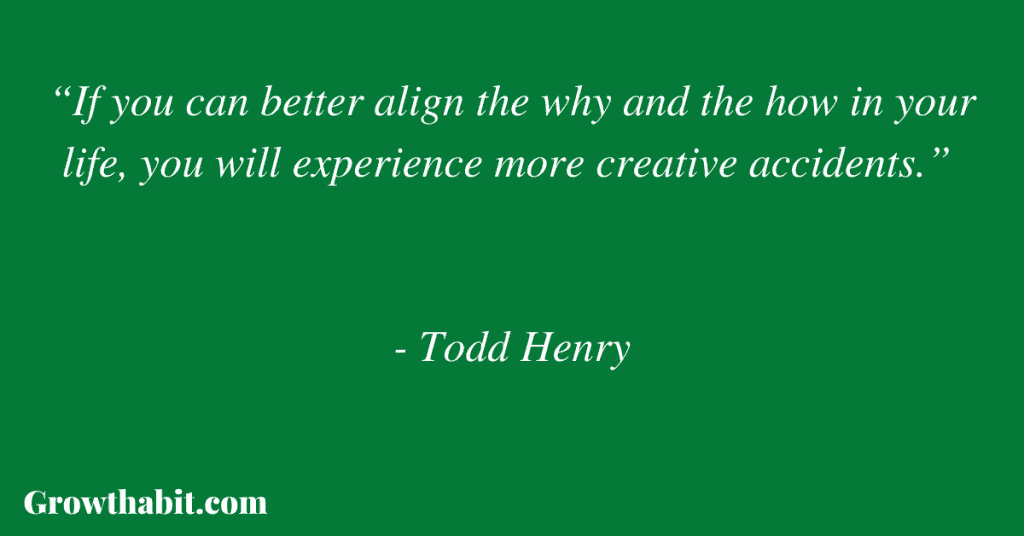
“But there are other people who derive their energy from filling other people’s buckets. They love the thrill of seeing other people come alive, of collaborating, of giving away their ideas and subsequently the credit they deserve. They recognize that more ideas will always come, but investing in relationships and maintaining an ethic of generosity yields results we can’t gain when we hold tightly and selfishly to what we think we deserve.”
“What are you currently interested in or curious about? What have you read or experienced recently that you think the other person knows very little about? What new insights or thoughts have you had that are ripe for application? These are all good topics for your head-to-head time.”
“Choose visionaries. At least one member of your core team should be someone who is a dreamer or a visionary. You want the kind of person who makes others nervous with the intensity”
“Take your relationships seriously and treat them with purpose. You will be rewarded many times over.”
Chapter 6. – ENERGY: YOUR INVISIBLE ALLY
“Each and every second, we encounter millions of stimuli in our environment, but we are conscious of only a few at any given time. Right now you are likely feeling the weight of this book (or your ereader) in your hands, the pressure of your chair on your rear, and the temperature of the air around you. But chances are you weren’t thinking about any of these before I called them to your attention. That’s because the only way you are able to survive as a human is by selectively ignoring stimuli that aren’t immediately relevant.”
“In many ways, you are defined by what you say no to. In design, they call this “negative space.”
Chapter 7. – STIMULI: WHAT GOES IN MUST COME OUT
“A good rule of thumb is that every single day should include some kind of stimuli that is directed at your personal growth (working through a book, studying a skill or technique, et cetera) and some kind of stimuli that you’ve sought out for purposes of advancing your work (an industry trend report, a research study, a trade magazine).”
”I must study politics and war that my sons may have liberty to study mathematics and philosophy.” —John Adams”
“Benjamin and Rosamund Zander write in The Art of Possibility, “The frames our minds create define—and confine—what we perceive to be possible. Every problem, every dilemma, every deadend we face in life, only appears unsolvable inside a particular frame or point of view. Enlarge the box, or create another frame around the data, and problems vanish, while new opportunities appear.”
“In his book The Contrarian’s Guide to Leadership, author and USC president Stephen Sample suggests that we spend the majority of our study time focusing on what he calls the “supertexts.” These are the works that have stood the test of time—Sample uses the examples of Machiavelli’s The Prince, various religious texts, and Plato’s Republic—in other words, texts proven by longevity to speak to the deeper human condition.”
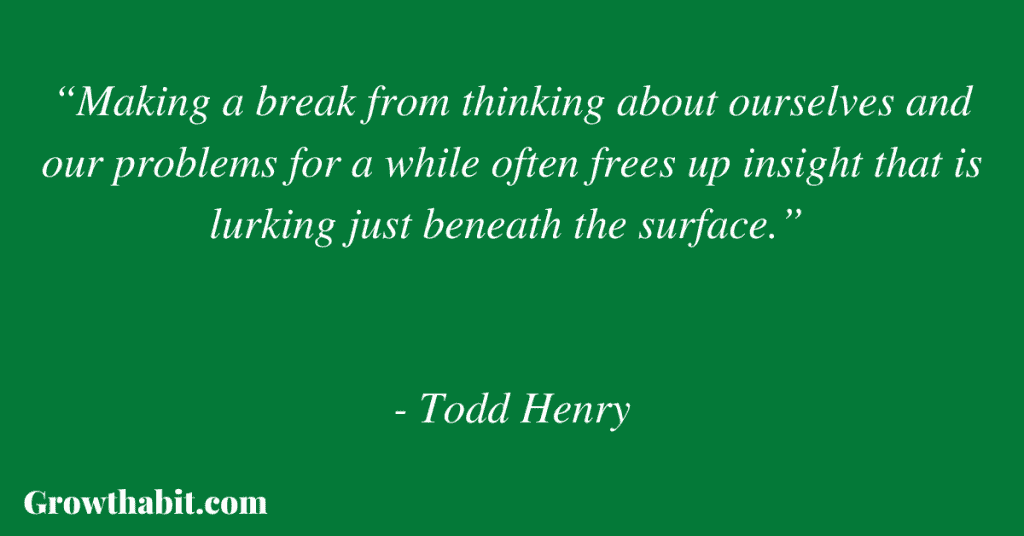
“How many times has a solution to a problem suddenly popped into your head and seemed so obvious that you thought there was no way you could forget it, and then you almost immediately did?”
“Are there any patterns in what you’re experiencing (or reading) that are similar to something else you’re working on? Often the solutions to your problems will come in the form of analogy or metaphor. If you look for similarities between your day-to-day experiences and the problems you’re working on, you may find unexpected connections.”
“Again, without regular review, the practice of note taking is fairly useless. It’s not about recording what’s happened; it’s about how what’s happened has affected or inspired you. By reviewing them regularly you increase the likelihood that they will be useful to you and that you won’t forget critical insights when things get hectic.”
“Making a break from thinking about ourselves and our problems for a while often frees up insight that is lurking just beneath the surface.”
Chapter 8. – HOURS: THEY’RE THE CURRENCY OF PRODUCTIVITY
“We must learn to spend our time effectively rather than obsessing about efficiency. To spend our time effectively means that we are willing to view our time as a portfolio of investments, not as a slot machine.”
“No matter what you say about your priorities, where you spend money and your time will prove them out. As the old saying goes, if you want to know what’s really important to you, take a look at your bank statement and your calendar.”
“Putting time on your calendar to generate ideas is worth it. It will change your life and your career. Remember: Successful, consistently brilliant people do the little (too obvious, too simple, too commonsensical) things that no one else is doing. This is what will set you apart, too.”
“The phrase “I don’t have time” really means “There are things that are easier/less threatening/more comfortable that I’d rather spend my time on.”
Chapter 9 – PUTTING IT ALL TOGETHER: THE CHECKPOINTS .
”Many have gone astray through not understanding how to continue a good beginning.” —Søren Kierkegaard”
“You probably don’t care about the pipes running through your walls (unless you’re a plumber); you just want the water they deliver. Similarly, you need to be mindful enough of your practices only to ensure that they are present and functioning properly, but remember that they are there to serve you, not the other way around. Any system tends to become more and more cumbersome to maintain over time, and that’s exactly what you must avoid. Simplicity is key. Simple rituals become habits, and good habits yield results.”
“People are brilliant at developing permanent solutions to temporary problems. Though you may not often recognize it, you probably see this all the time in your organization. This is why we often see big, cumbersome bureaucracies within companies. Many of those bureaucratic systems were developed to deal with pressing problems at some point in the past and have now become energy zapping dinosaurs. It also happens in our personal life. We develop habits to resolve problems, such as e-mail inundation, lack of energy, or a desire for relational connection, but then these habits live on once our needs have been met. The Checkpoints ensure that these personal bureaucracies don’t take over your life and kill your best work.”
“It’s like climbing a really tall tree to get your bearing and take a look at the upcoming terrain. It may seem like a temporary diversion, but this can make you much more effective as you continue your journey.”
Chapter 10. – COVER BANDS DON’T CHANGE THE WORLD
“Over time, many of the practices in this book will become second nature. They will simply become intertwined with your lifestyle and creative process. But like anything else worthwhile, your first efforts will require a tremendous amount of forethought and follow-through.”
“Intentionality means that you are approaching your life in a systematic way and not haphazardly. You know what you’re about and you’re working a system to make it happen. It means that you must constantly remind yourself of not only what you’re doing, but why you’re doing it (Checkpoints).”
“Choice means that by saying yes to a set of practices, you are inherently saying no to a lot of other things. You can do almost anything you want, but not everything you want. What you choose to include in your life has consequences and immediately limits your other choices. Therefore, you must be careful when making commitments so as to not unintentionally limit your opportunities for engagement.”
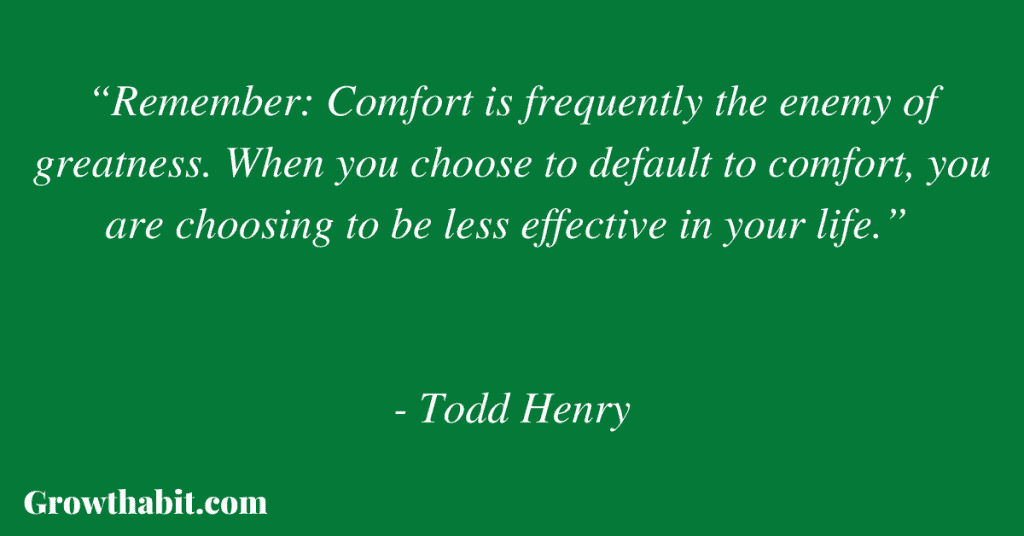
“Remember: Comfort is frequently the enemy of greatness. When you choose to default to comfort, you are choosing to be less effective in your life.”
“Discipline involves establishing and hitting specific marks and doing what needs doing regardless of how you feel in the moment. It means that you make decisions when you have clarity and sufficient energy, then you follow through on them regardless of how you feel in the moment.”
“As author André Gide wrote, “One does not discover new lands without consenting to lose sight of the shore for a very long time.” This is not to imply that there’s anything wrong with imitation. In fact, it’s one of the critical phases of creative growth. We need to feel free to imitate others as we learn and develop our skills. But it gets tricky when we start making money based solely on our ability to imitate the creative work of others.”
“There is no greater reward than that of knowing that you are free from the need to be defined by pay or prestige, and are instead motivated by the very process of doing your work each day. This is how we begin to see the seeds of greatness spring up in our life.”
Book Review (Personal Opinion):
This is a solid book from a creative who knows what they’re talking about. The book surgically cuts through a life of a creative and pinpoints where you need to pay attention and what you need to do. It’s a way different book than Keep Going by Austin Kleon and way more systematic in its approach.
Rating: 7/10
This Book Is For (Recommend):
- A creative who is struggling to keep focus on things that matter
- An aspiring blogger who needs to learn how to produce prolifically
- Anyone who needs motivation through creating systems that work
If You Want To Learn More
Here’s Todd Henry talking about creativity at STORY 2018.
STORY 2018
How I’ve Implemented The Ideas From The Book
There’s quite a lot I implemented from this and I didn’t learn all of it from this one. But the one lesson I did learn is to separate my conceptual/thinking time with my execution time. The problem I had in creating articles was that I didn’t have enough time set in my calendar to sit and let my creative juices going on. The Accidental Creative helped me fix that.
One Small Actionable Step You Can Do
The book mentions relationships as a fundamental pillar to creative work and they are based on two critical elements: generosity and intimacy. Check out your relationship and see how you can improve on both of them.
